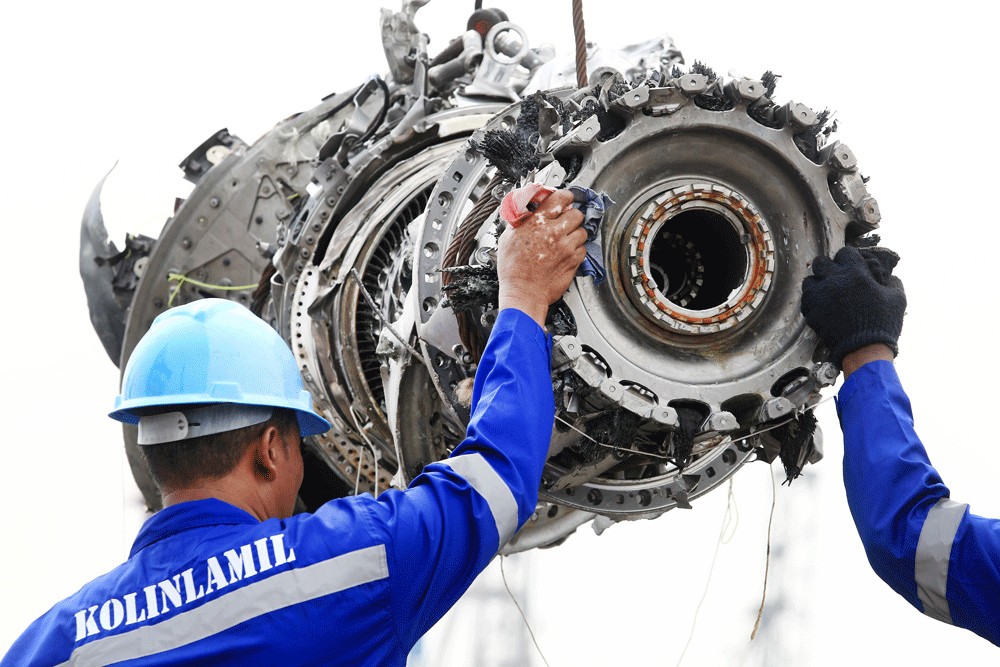Popular Reads
Top Results
Can't find what you're looking for?
View all search resultsPopular Reads
Top Results
Can't find what you're looking for?
View all search resultsFaulty 737 sensor in Lion Air crash linked to US repairer
Accident investigators in Indonesia, home of Lion Air, and the US, where Boeing, the plane’s manufacturer, is based, have been examining the work that a Florida repair shop previously performed on the so-called angle-of-attack sensor, according to briefing documents prepared for Indonesia’s parliament.
Change text size
Gift Premium Articles
to Anyone
 Huge task: The turbine of downed flight JT610 is unloaded from the KRI Banda Aceh onto Jakarta International Container Terminal (JICT) 2 in Tanjung Priok Port, North Jakarta, on Saturday. The turbine is being analyzed by the National Transportation Safety Commission (KNKT). (The Jakarta Post/Dhoni Setiawan )
Huge task: The turbine of downed flight JT610 is unloaded from the KRI Banda Aceh onto Jakarta International Container Terminal (JICT) 2 in Tanjung Priok Port, North Jakarta, on Saturday. The turbine is being analyzed by the National Transportation Safety Commission (KNKT). (The Jakarta Post/Dhoni Setiawan )
A
faulty sensor on a Lion Air 737 Max that’s been linked to the jetliner’s deadly crash last October and a harrowing ride the previous day was repaired in a US aircraft maintenance facility before the tragedy, according to investigative documents.
Accident investigators in Indonesia, home of Lion Air, and the US, where Boeing, the plane’s manufacturer, is based, have been examining the work that a Florida repair shop previously performed on the so-called angle-of-attack sensor, according to briefing documents prepared for Indonesia’s parliament.
Erroneous signals from that sensor triggered the repeated nose-down movements on the Oct. 29 flight that pilots struggled with until the jet plunged into the Java Sea, killing all 189 people aboard, according to a preliminary accident report by Indonesian investigators.
The Lion Air crash and a similar one about five months later involving an Ethiopian Airlines 737 Max together prompted the grounding of Boeing’s best-selling jet March 13 and touched off a global rebellion against US aviation regulators. Investigators have focused on the sensor’s role in the two disasters.
Much of the concern by regulators and lawmakers after the Lion Air and Ethiopian Airlines crashes has focused on Boeing’s design of the Maneuvering Characteristics Augmentation System, or MCAS, which was programmed to push down a plane’s nose to help prevent aerodynamic stalls in some situations. Initially the MCAS system was designed to push the plane’s nose down if one of the angle-of-attack sensors indicated it was in danger of going into a stall.
But the preliminary report by Indonesia on the Lion Air crash shows that maintenance and pilot actions are also being reviewed.
Documents obtained by Bloomberg show the repair station XTRA Aerospace in Miramar, Florida, had worked on the sensor. It was later installed on the Lion Air plane on Oct. 28 in Bali, after pilots had reported problems with instruments displaying speed and altitude. There’s no indication the Florida shop did maintenance on the Ethiopian jet’s device.
The Indonesian National Transportation Safety Committee is seeking data “from repair station in Florida” where the unit was worked on, the investigative agency said in a briefing to parliament last November and contained in a presentation.
“Our thoughts and condolences are with all those who have lost loved ones in the recent 737 Max 8 accidents,” XTRA Aerospace, a unit of Wencor Group said in a written statement. The company, it said, “is fully committed to supporting any investigations into this matter.”
Nurcahyo Utomo, lead investigator at the Indonesia NTSC, said the US National Transportation Safety Board was conducting a review of the work performed on the sensor, but hasn’t yet reported back on its findings.
The sensor was made by Rosemount Aerospace, of Minnesota, a subsidiary of United Technologies. United Technologies declined to comment, citing the investigation.
The sensor involved in the crash wasn’t working from the time it was installed, according to the NTSC’s preliminary report on the accident.
Angle-of-attack sensors, which operate like a wind vane on the side of a jet, are designed to show how air is flowing relative to where the nose is pointed and alert pilots of a too-steep climb that could result in an aerodynamic stall. In the case of the Lion Air flights, the left-side sensor was showing the nose pointed about 20 degrees higher than was actually the case.
It was that erroneous reading that caused an anti-stall computer system to assume the plane was in danger of losing lift and to repeatedly try to push down the nose on the final flight and the one that preceded it, according to the preliminary report that cited information from the plane’s crash-proof data recorder.
XTRA Aerospace is certified by the US Federal Aviation Administration to perform repairs on multiple Boeing and Airbus SE models, according to its website.
US teams assisting the Indonesian investigation reviewed the work by the company to ensure that there weren’t additional angle-of-attack sensors in the supply chain with defects, said a person familiar with the work. They didn’t find any evidence of systemic issues on other sensors the company may have worked on, said the person, who wasn’t authorized to comment on the work and asked not to be identified.
Representatives of the NTSB, which is assisting Indonesia and Ethiopia in their crash probes, and the FAA, which is also participating, said they couldn’t comment on a foreign accident investigation. Lion Air spokesman Danang Prihantoro declined to comment on the inspection of the sensor, citing the ongoing accident investigation, or identify the company that worked on the part.









